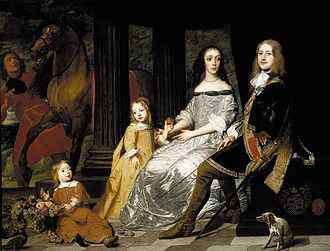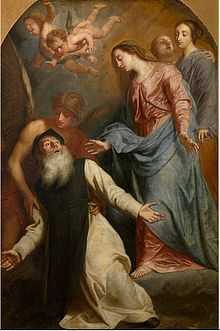Pieter Thijs

Pieter Thijs, or Peeter Tysens (Antwerp, 1624?–1677) was a Flemish Baroque painter of portraits as well as religious and history paintings, whose work was heavily influenced by the courtly and elegant style of Anthony van Dyck.
Biography
Pieter Thijs was born in a modest family as the son of a baker. Thijs had three masters. He trained with Artus Deurwerdeers as a cabinet painter, in the style practiced in the workshop of Frans Francken the Younger, the father-in-law of Deurwerdeers. It is only after moving to the workshop of Anthony van Dyck that Thijs learned portrait and history painting and started copying the great masters. He is considered to be van Dyck's last pupil. Everything suggests he completed his training with Gonzales Coques, in whose workshop he subsequently worked as a master for more than three years. Thanks to the presence of the collection of George Villiers, 1st Duke of Buckingham, in Antwerp, he was able to study the paintings of the Cinquecento.[1] He became a master of the Antwerp Guild of St. Luke in 1644–45.[2]
He then started out on a career that was successful despite the prevailing dire economic situation in Antwerp. He maintained a busy workshop that employed about twenty apprentices in the course of his career. In the 1660s he had enough work to keep six assistants busy. He obtained many commissions for altarpieces in churches in Flanders and Brabant as well as for portraits, and allegorical and mythological paintings from patrons in both the Southern Netherlands and the Dutch Republic. Through the international business connections of his father-in-law who ran a large import-export business in Antwerp with offices in the major ports and cities of Europe, he was able to sell his paintings to an international clientele and get commissions for altarpieces in Vienna and Croatia as well as for the Cologne Cathedral.[1] He enjoyed royal patronage. From 1647 onwards, he became a portrait painter as well as a tapestry designer for Archduke Leopold Wilhelm of Austria, then the Governor of the Southern Netherlands, while at the same time taking on commissions from the rival House of Orange in The Hague.[2]

He played a mayor role in Antwerp’s cultural life. He served as deacon and treasurer of the Antwerp Guild of Saint Luke and was the driving force behind the further development of the Chamber of rhetoric of this guild. He was able to persuade the local playwright William Ogier to compose several works for the theater.[1]
He had a son by the same name and was the teacher of Jan Fransicus Lauwereyssens.[3]
Work
He gained a reputation for large family portraits, a genre made popular by his teacher Anthony van Dyck.[3] His portraits followed the style of van Dyck in the eloquence of the hands and the meticulous execution of the reflections on the shimmering fabric.[1] Though a popular portrait painter, the early Flemish biographer Cornelis de Bie stated that his likenesses were criticized for being unlike their subjects.[4]
His religious works were also influenced by the style of van Dyck, except for those paintings on the subject of the Descent from the Cross that follow the composition and palette of Rubens who had produced some influential paintings on this theme. His history paintings show the influence of French classicism, which was then coming into fashion, while putting emphasis on prettiness and polished finishing. He also borrowed from the Itailan masters of the Cinquecento, such as Titian and Veronese. He showed himself to be an eclectic painter who did not strive for originality but adapted and borrowed from the styles of other artists where he felt the commission demanded it.[1]
As was quite customary in those times, he often collaborated with other artists and, for instance, added figures to works by the animalier Pieter Boel.[5]
References
- ↑ 1.0 1.1 1.2 1.3 1.4 Summary of the doctoral thesis of Danielle Maufort, 'Le peintre anversois Pieter Thijs (1624-1677) : l'un des derniers élèves d'Antoine van Dyck' (French)
- ↑ 2.0 2.1 Hans Vlieghe, "Thijs, Pieter." Grove Art Online. Oxford Art Online. Oxford University Press. Web. 19 Feb. 2014
- ↑ 3.0 3.1 Pieter Thijs in the RKD (Dutch)
- ↑ Het gulden cabinet vande edel vry schilder const, online facsimile version in Google books, p. 328
- ↑ Pieter Thijs and Pieter Boel (Flemish, 1624 –1677 and 1622 - 1674) at the Cummer Museum of Art and Gardens
Further reading
- Vlieghe, Hans (1998). Flemish Art and Architecture, 1585-1700. Pelican history of art. New Haven: Yale University Press. ISBN 0-300-07038-1
| Wikimedia Commons has media related to Pieter Thijs. |
|